When it comes to crate training you will be happy to know that there is a simple formula that sets you up for guaranteed success. Today we are going to teach you how to use it!
After hours and hours of reading books from the greats in dog training and five months of patiently puppy training my own dog, using their methods, we have concluded that crate training can be organised into one simple formula!
We call it the “Crate Training Success Formula”.
In this guide, we will explain how to easily implement this formula in three easy steps without needing a degree in dog psychology or even dog training.
Dog trainers believe that crate training should only be used while your dog undergoes other types of training such as puppy toilet training, puppy sleep training, house training etc.
So we have broken the guide down into sections to help you understand why you are crate training and how to crate train for that specific reason.
Are you ready? Here we go!
Related: Dog Crate Sizes Based on Breed and Health History
Crate Training Strategies from THE Experts
The create training guide has been masterfully created by leaning on three major dog trainers of our time. Doggy Dan, Cesar Millan and Dawn Sylvia-Stasiewicz.
Crate Training Advice From Doggy Dan
You may have heard of him, New Zealand’s own, Doggy Dan who is gaining international traction for his holistic dog training ways.
He has helped over 37,000 people successfully train their dogs through his paid online training course, the Calming Code and The Perfect Puppy Program in which we had the privilege to undertake.

Today, we give you some insights into how Doggy Dan crate trains his own pup Moses through his paid online courses.
Crate Training Advice from Cesar Millan
We have added the cherished wisdom of our favourite Mexican-American dog behaviourist and TV celebrity, Cesar Milan with over 25 years of canine experience to this guide.
We have extracted everything you need to know from his best selling dog training books (How to Raise the Perfect Dog; Through Puppyhood and Beyond and Cesar’s Way; The Natural, Everyday Guide to Understanding and Correcting Common Dog Problems) into easy to follow crate training schedules for your convenience.
Crate Training Advice from Dawn Sylvia-Stasiewicz & Larry Kay
And finally, Dawn Sylvia-Stasiewicz and Larry Kay the author an international best selling dog training book – Training the Best Dog Ever, A 5-Week Program Using the Power of Positive Reinforcement, is a book based on love and kindness. Barack Obama’s dog trainer when he was President, .
You may recognise these trainers and their valuable techniques from our other posts on dog training, that’s because these guys truly know what they are doing.
This crate training guide is full of invaluable advice from these trainers who are experts in crate training.
Good Crate Training vs Cruel Crate Training
Before we go any further its important you understand the difference between good crate training and cruel crate training. Its a very touchy subject but does deserve to be mentioned.
Crate training is the process of using a crate as an appropriate enclosure to eliminate unwanted behaviour (peeing on the carpet) WHILE training your dog desired behaviours (peeing outside).
If you use a crate instead of teaching your dog the house rules then most people would agree that crate training is cruel and in fact some countries have even banned crate training for these reasons.
The Approved Reasons for Crate Training
So good crate training is when you use a crate WHILE you teach your dog the rules of the house.
All three dog trainers agree that, when done correctly, the successful use of crates will curb destructive tendencies, while giving your pup a safe space to adjust to the rules of the house.
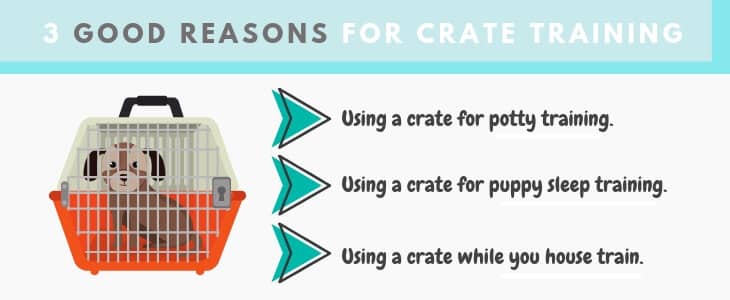
Generally speaking, the house rules can be broken up into three categories of training, potty training, sleep training and house training (what is and isn’t acceptable to chew for instance).

Doggy Dan, promotes the practice of crate training as an effective way to establish leadership and correct behaviour when done correctly and with a lot of love and patience.
He goes on to teach that crate training is a great means to an end, the end being a well-trained house pet who spends more time outside the crate
— Doggy Dan
Bottom Line: While it is not a cure-all for puppy problems, crating can be a beneficial tool for setting boundaries and expectations for your dog.
Choosing the right crate
Choosing the right crate is fundamental in successfully crate training your pooch.
There are many things to consider when shopping around (or building one yourself)– selecting the wrong enclosure could cause a whole array of new problems!
Housing your dog in a too small crate can be detrimental for their physical and emotional well-being, causing serious health concerns from stunted growth and arthritis to anxiety!
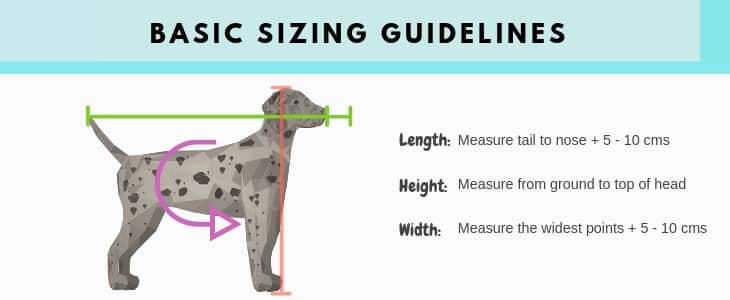
An appropriate crate is just large enough for them to stand and turn around comfortably, without giving them extra space to get into mischief!
Newer wire cages often come with a removable separator to block off extra room for growing dogs– this is especially helpful with larger breeds!
The most basic way to measure your dog for a crate is to add 5-10 cm to the length and width. However, there any many other important variables to take into account, like breed, temperament etc. We will go into this now.
Study your dog.
Take into account the size, breed, and temperament of your puppy. For example, a high-energy bully breed can easily disassemble a plastic carrier style– this breed would benefit more from a sturdy wire cage with a lot of visibility.
On the other hand, keeping a teacup Yorkie in the same size wire enclosure could be counterproductive for house training.
Typically a dog will not eliminate where they sleep or eat, but an oversized crate can allow for dogs to snooze on one side and potty on the opposite end!
Consider your dog’s breed and size.
Timid toy breeds will likely be more comfortable in a soft-sided cage or a carrier style with plastic sides–the limited visibility will help them feel protected from “predators.”
Small dogs such as Jack Russells or Pugs are well-suited for playpen, soft-sided, and plastic enclosures. If your dog falls into this category, consider it’s temperament and energy level.
Energetic dogs on the smaller end of this spectrum do well with a playpen style set up, but heftier canines might just topple the pen over!
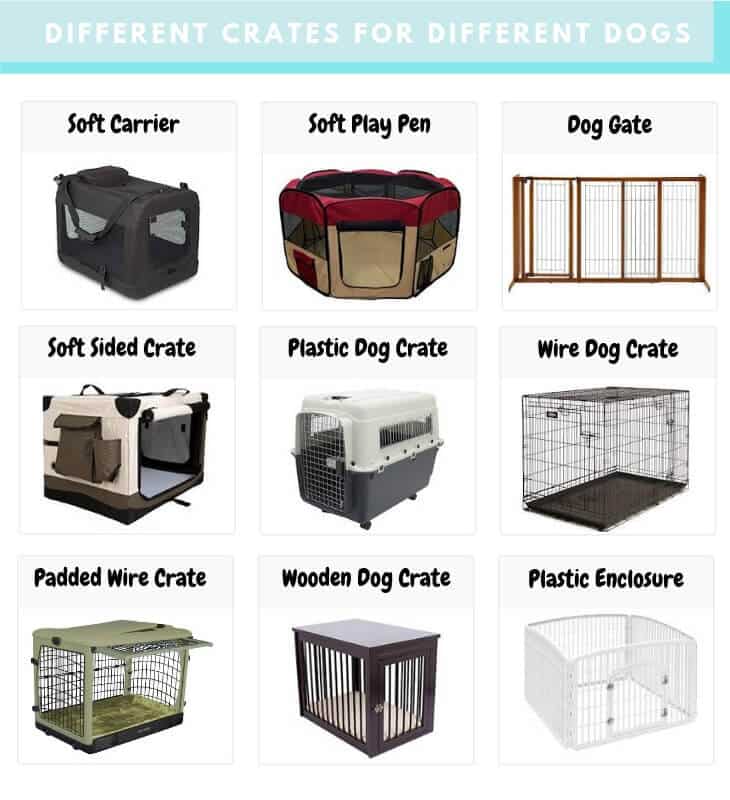
Medium sized dogs have a wide assortment of crates to choose from, like the Whippet or American Bull Dog, could suit soft-sided, plastic, playpen, and wire crates.
If your mid-range dog is prone to escaping, go for a wire crate–but you may need to pad the bars if you have a chewer!
Extra large dogs like the Great Dane, should give wooden crates a try.
Powerful big stature dogs which easily break out of flimsy wire cages will have a much tougher time making escaping from a sturdy wooden setup.
Here is a general guide for selecting the most appropriate crate size and style per dog breed.
Please note that your dog’s personal temperament must be taken into consideration before relying on the below recommendations.
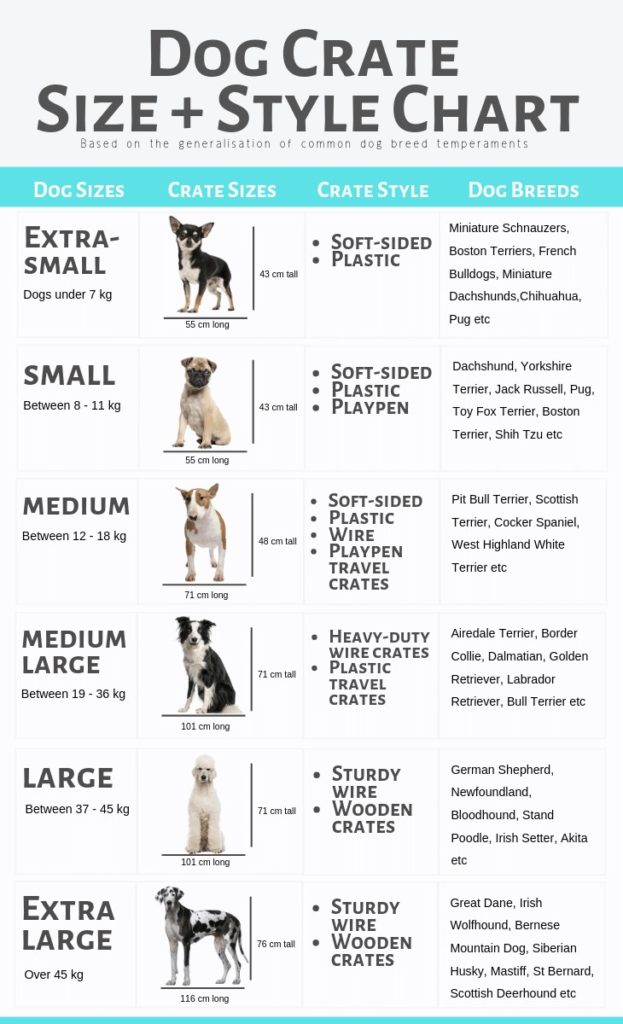
The Crate Training Success Formula
Now that you have chosen the right size crate for your dogs breed, size and temperament, you are ready for the next step.
We can now finally reveal the special formula that will solve all your crate training problems!
As promised, here it is. The Crate Training Success Formula:

I know it doesn’t look like much but it yields incredible results and that’s why professional dog trainers use it and recommend it.
It looks simple and that’s because it is. It just takes some understanding of your dog and some planning, oh and patients!
In this section, we break this down into three easy, manageable steps for you.
The 3 Easy Steps to Crate Training
Step 1 – Know your intentions for crate training.
Step 2 – Prioritise your puppy training program.
Step 3 – Commit to a schedule that works with your intentions.
Sounds easy and is it. Let’s get into it.
Step One: Know your intentions for crate training.
So why are you crate training? By now you should have given some thought as to why you have chosen to crate train. In this guide we have catered to the three most common reasons for crate training.
Choose a reason that closely relates to your reason for crate training;
a) I am trying to potty train my puppy.
b) I am trying to teach my puppy to sleep at night.
c) I am trying to teach my puppy to be well-behaved when left alone.
Bottom Line: Choose your intention and then move on to Step Two.
Step Two: Prioritise your puppy training program.
The latest research from numerous case studies conducted by the Journal of Applied Animal Behaviour Science, reveals that a well-trained puppy is highly unlikely to suffer from behavioural problems as a grown dog.
This tells us that behavioural issues such as destructive chewing, self-harming, and anxiety can all be solved through…you guessed it… puppy training!! And the sooner, the better!
To save you a lot of time we have summarised and condensed Doggy Dan’s paid online puppy training course into an easy to follow guide.

The Online Dog Trainer uses the ‘Calming Code’ as a basis of his ‘Perfect Puppy Program’ for training your puppy to be well behaved and happy.
Doggy Dan believes that once this is in place, crate training becomes a dream.
— Doggy Dan’s Take
We have summarised these paid programs for you here.
The program is self-paced, making it very effective for puppies and dogs of any temperament.
Our advice is to stick with it and get everyone in the pack involved. This is just one method you can try out, there are many other dog training methods out there for you to explore.
If you don’t have time then you can enrol your dog into a local puppy training school. This can be very rewarding for you and your pooch.
We still use Doggy Dan’s techniques and we can vouch that they do work, they are very simple. Although, you do have to be vigilant and very patient for the techniques to work properly.
Bottom Line: Committing to puppy training course is really important while you undergo crate training. It will put a stop of bad behaviours sooner so the crate can be stored away.
Step Three: Try a schedule that works with your intentions.
For some of us sticking to a schedule makes us cringe. I get it. But it can really set you up for success and it doesn’t have to be forever.
For each intention we have provided you with a schedule. All you have to do is adjust it to suit your lifestyle.
The schedule is there to help you understand your puppy’s unique behaviour and for the puppy to understand what is expected.
Honestly, the magic happens when you use a schedule.
Sticking to the schedule allows for consistency, consistency leads to results.
Choose a schedule that aligns with your intentions:
- Crate Training Schedule – Potty Training
- Crate Training Schedule – Sleep Training
- Crate Training Schedule – Being Left Alone
Remember, it’s not forever. It’s just here to fast track the crate training process.
Bottom Line: Stick to a schedule. Tailor it to your lifestyle and be consistent until you see results. Remember, this is a proven to work technique. Try it out and see for yourself.
Now that you have your crate, intention and your schedule, you are ready to learn how to put it into action. Choose the action plan for your intention.
How to crate train a puppy for potty training
If your intention is to use a crate while little Fido is learning how to hold his bladder and learning where to potty, then crates can be a great tool.
Depending on your work/life schedule, ideally, you would only have your puppy in the crate at night.
All you need for this method is the bladder formula, a potty training schedule, treats and lots of love and patience.
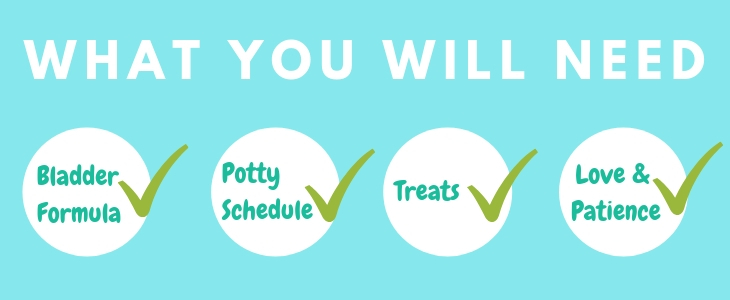
How long does it take to potty train a puppy? It depends on which dog training method you follow (positive reinforcement, clicker training, electronic training, mirror training, relationship-based training, alpha dog training, dominance training).
For simplicity and effectiveness, we have based our recommendations on mainly alpha dog training and positive reinforcement (Doggy Dan’s Methods).
Note: If you live in a house with a yard, the process will be much faster. If you are in an apartment, it’s slightly different and requires a little more patience, more about that here.
Lets get into how it works…
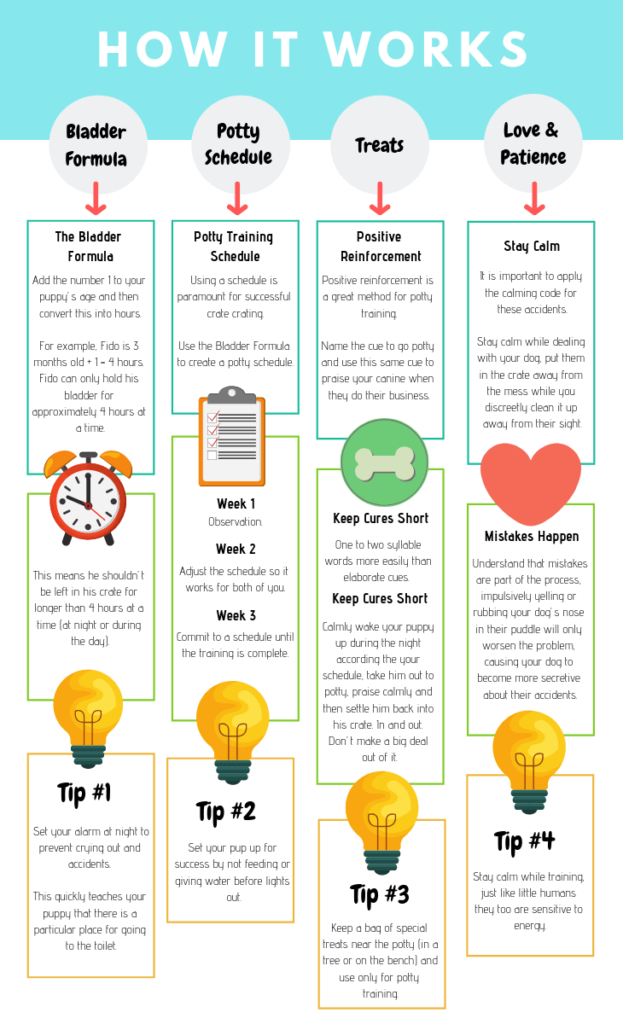
1. The Bladder Formula.
A puppy under 10 weeks old is physically unable to hold their bladder throughout the night. An easy rule of thumb to follow is a formula called the bladder formula.
The Bladder Formula
Add the number 1 to your puppy’s age and then convert this into hours.
For example, Fido is 3 months old + 1 = 4 hours. Fido can only hold his bladder for approximately 4 hours at a time.
This means he shouldn’t be left in his crate for longer than 4 hours at a time (at night or during the day).
The potty training schedule provided will allow you to use the bladder formula to plan out your day and night.
The biggest benefit to sticking to this formula and a schedule is that it quickly teaches your puppy that there is a particular place for going to the toilet.
He won’t have time to pee in his crate because you will be knocking at his door every four hours!
Bottom Line: Get committed by setting an alarm clock and be ready for a toilet trip. This is what the schedule is for. The more consistent you are, the faster he will learn! I promise!
2. Plan ahead! The Potty Schedule for Crate Training.
You know by now that sticking to a schedule is absolutely paramount for successful crating. This not only avoids smelly and uncomfortable accidents but it trains your pup to NOT cry out. Crying spells will be totally avoided.
So plan ahead and get your schedule ready. Let’s get into it.
Your schedule will be broken up into weeks;
Week One – Observation.
Week Two – Adjust the schedule so it works for both of you.
Week Three – Commit to a schedule until the training is complete.
For some, after week three the training is complete and the crate can be put away.
For others, the puppy might grow attached to the crate and prefer to use it while taking himself to the toilet during the night, with the exceptions of a few mistakes here and there.
If after week three, there is no progress, then go back to the Perfect Puppy Program and step through the fundamental training rules.
Sometimes the way we say our cues, or the way we feed or discipline our puppy, can create trust or respect issues which in turn makes potty training and crate training much more difficult.
Tip: Set your pup up for success by not feeding or giving water before lights out.
Try to make their last meal and drink about three hours prior to bedtime, this will prevent any restlessness and the unnecessary need for going to the toilet.
If you haven’t got it already, here is your Potty Training – Crate Training Schedule.
If you want to follow the Perfect Puppy Program, here is a schedule that reflects Doggy Dan’s leadership training for Potty Training.
3. Reward and praise.
Everyone loves to hear that they are doing a good job and your pup is no exception!
The greatest dog trainers of our time, rely heavily on “positive reinforcement’ as the best training method, for standard house pets, especially for potty training.
Take Dawn Sylvia-Stasiewicz, the dog trainer to President Obama’s family dog, as a great example.

Dawn suggests naming the cue to go potty and using this same cue to praise your canine when they do their business.
— Dawn Sylvia-Stasiewicz’s Take
You may be surprised at how fast your puppy learns the connection between the two. Especially if you take Doggy Dan’s advice and give a little treat when doing so. This is guaranteed to speed up the success. It did for my dog and it worked!
Say something like, “go toilet” when they go outside and “good toilet” to praise them for eliminating in the appropriate place.
Keep Cues Short
One to two syllable words more easily than elaborate cues. Add treats IF this is part of your puppy training program.
Crating at Night
If you are using the crate at night to stop your puppy from doing his business all over the house, then be sure to calmly wake him up, take him out to potty, praise calmly and then settle him back into his crate. In and out. Don’t make a big deal out of it.
TIP: The Perfect Puppy Program suggests saving special cuddles or treats for potty training. Keep a bag of special treats near the potty (in a tree or on the bench) and use only for potty training.
Remember that accidents happen!
Just like human children, puppies have accidents from time to time–especially before they learn the ins and outs of the house rules.
Understand that mistakes are part of the process, impulsively yelling or rubbing your dog’s nose in their puddle will only worsen the problem, causing your dog to become more secretive about their accidents.
It is important we apply Doggy Dan’s calming code for these accidents.

“Stay calm while dealing with your dog, put them in the crate away from the mess while you discreetly clean it up away from their sight.”
— Doggy Dan
Even though we have a formula that tells us how often Fido needs to go to the toilet, we have found that sometimes pups have the tendency of changing their own pee schedule, even if one drop comes out.
For now, logging your pup’s elimination patterns may help to predict when accidents are most likely to happen, and prevent them before they occur.
Positive reinforcement training will teach little Fido to hold until he actually needs to go. This is very powerful.
Bottom Line: Try and stay calm while training, just like little humans they too are sensitive to energy.
Crate training at night – Teaching your pup to sleep through the night
Crate training at night is nothing to lose sleep over, as long as you have a little patience and make some preparations beforehand!
If your intention is to train your puppy where to sleep at night while using a crate then this is one of the easiest methods.
Before you Begin Make the Crate Comfortable & Inviting
Make sure your pooch is accustomed to the crate before you put them in for the night.
Spend some time during the day acclimating them to the enclosure, scatter treats around it, and encourage them to investigate.
Put some cozy blankets and some soft toys in to make it as inviting and relaxing of an atmosphere as possible–with some time your dog will be retreating to this space by their self to take a cat nap or to get away from the household hustle and bustle.
Bottom Line: Spend some time turning the crate into a safe haven for your puppy.
Crate Training: Whining, barking, and crying.
It’s hard not to make a fuss when your pup is crying and barking all night in their crate. Although saddening and often aggravating, it is an issue that nearly every crate-training fur-parent has encountered.
Tips for Soothing an Upset Puppy
If your puppy to crying out at night try some of these soothing recommendations from Rebecca Setler, the author of Puppy Sleep Training.
Rebecca suggests trying a sound machine or fan pointed away from your pooch to soothe them and block outside noises.
The book goes on to recommend using some plush toys come with a built-in “heartbeat” this could help ease your puppy’s mind–just make sure there are no plastic pieces that your teething puppy could hurt himself on.
Covering the crate with a light blanket or towel help some dogs feel hidden from predators–other dogs will pitch a fit if you cover their crate.
Just like some humans sleep with the door open and others sleep with it closed, it is just a matter of personal preference!
Some dogs even find comfort in sleeping with a worn shirt that belongs to their owner.
Take some time to troubleshoot and try different ideas to figure out what works best for your dog.
Tips for Not Giving In
Doggy Dan’s number one rule for nightly crate training is to not to give in.

“Often puppies bark the loudest right before they drift off to sleep, like a last stitch effort to get you to let them out. As hard as it is, try your best to not give in.
If your pup is absolutely frantic for a long while, calmly let them out to potty and take them straight back to the cage.
— Doggy Dan
Do not play with, pet, talk to, or cuddle them during this time.”
It is important to make this step straight to the point– this teaches the dog that barking and fussing will not get them out to play or petted.
Stay calm during this period, don’t throw them back in the pen and slam the door–remember, a crate is supposed to be their safe place, never a place of punishment!
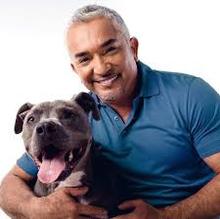
The Dog Whisperer – Cesar Millan believes this act of staying calm when showing leadership, is the absolute key to building trust in the eyes of your puppy.
— Cesar Millan
Bottom Line: The calmer you are when the puppy is distressed, the more he will look to you for guidance.
Busy Dogs are Happy Dogs
Rebecca Setler insists that keeping your dog active during the day is paramount for a puppy to adjust to sleep through the night.
Going for walks, practising fetch, and having play-dates with other four-legged people are all fantastic ways to expend some of that bubbling puppy energy!
Learning how to stimulate your pup is very important. Both Cesar Millan and Doggy Dan agree that the key to success is all within your ability to meet your dog’s needs.
If your dog is fulfilled (mentally and physically stimulated), then they will want to please you in return.
Establishing a Routine
It is important that fulfilling your dogs needs becomes part of your daily routine. Learn how to stimulate your puppy and recognise which types of stimulation are best received by your pup.
Some examples are; learning new tricks, off leash exploring (hiking/beach), problem solving obstacle courses and obedience training.
Keep trying until you find what works for you and your puppy. You will be able to instantly tell when your pup is enjoying himself.
Implementing an exercise routine becomes easy when you stick to a schedule, the schedule will teach the puppy when it is exercise time and when it is SLEEP time. This can be very effective.
You can find more solutions on how to get a puppy to sleep here.
Bottom Line: The more you make an effort with your puppy, the easier it is to train them when and where to sleep.
Tips for Where to Place the Crate
Consider putting the crate in your bedroom for the first few nights, just until your pup gets used to the routine. Being able to see and hear their owners breathing helps a new puppy feel secure in the crate and lets them know they are not alone!
Elevating the Crate
Rebecca Setler recommends elevating the crate so they can see you while you sleep–be sure to secure it well, you don’t want it tumbling to the floor with your beloved pooch inside!
Playpen Enclosure
Doggy Dan recommends setting up a playpen where the puppy can roam around his enclosure in between naps.
The playpen has the crate, with the door open, toys and a pee pad. This allows the puppy to get distracted and likely to settle himself down.

Doggy Dan also gives the option of setting up the enclosure near your bedroom and then gradually moving it out further away toward the area where you want the puppy to sleep indefinitely.
— Doggy Dan’s Take
Rooming-in depends on the household. If you are a working family then maybe it’s better to set the enclosure up in the area you want from the beginning.
Playing soft music as mentioned earlier, dimming lights and the like will soften the stress and make the transition easier.
Bottom Line: Moving the crate to your bedroom at the beginning is a personal preference.
Crate Training While at Work
Being a working dog parent is a challenge in itself, but when you add crating into the mix, it can become even more stressful. The good news is, it doesn’t have to be!

In the words of Doggy Dan, “Set your dog up for success”!
Always feed and toilet your beloved pooch right before crating and never leave them confined for longer than they can hold their bladder.
— Doggy Dan’s Take
Young puppies and small breeds may only be able to contain their water for an hour or two. Puppies six months or older should be fine for four to seven hours. Go back to the Bladder Formula for more information.
Practice makes perfect!
Cesar Millan suggests finding creative ways of rehearsing for the big day beforehand. Leave your pup in the crate for literally one second and work up in increments a little at a time.
Try this without closing the door first and work up to closing the door. A few treats and some encouragement go a long way during this step!
Give Fido something to do!
Put a few interesting toys in the crate to occupy their time (maybe a rubber chew toy filled with peanut butter and their favourite plush to cuddle up to).
Having several options to play with will keep them entertained so (hopefully) they will barely notice you left!
Keep your cool!
Doggy Dan’s Calming Code is a very effective strategy for keeping your canine cool and collected upon your departure and arrival. He teaches us always to be relaxed when interacting with our dogs.
A consistently calm demeanour gently asserts dominance which helps your dog to feel safe (since you are in control, they don’t have to worry!).

Cesar Millan also affirms this principle in his book “Your Way to Train a Well-Behaved Dog,” telling readers to “Make sure your own demeanour is calm and steady. The more times you’ve shown leadership in different environments, the more your dog will trust you even when she’s unsure.”
— Cesar Millan’s Take
Take your time!
When you come home, don’t rush to the cage in a frenzy! Take about five minutes to get settled in before you approach the pen.
Do not speak or make eye contact with your pup during this period–overtime this can cause or exacerbate hyperactivity and whining.
Do not let your dog out while they are whining–this teaches them that barking gets them what they want. Giving in will only condone negative behavior, they will learn that you will let them out but on your terms, not theirs.
If they are calm and five minutes have passed, approach the crate CALMLY, and take them straight outside to potty. When they finish their business, praise them and give them the pets that you both have been longing!
Following these steps is vital for creating a calm and obedient dog, mistakes are bound to happen, but patience and consistency are key!
Read more about crate training for working dog parents here which includes an elaborate schedule for working dog parents.
Author’s Note: I used a modified version of this method with my (now 8-year-old) beagle, Trixie. Beagles have some of the best noses in the dog world and are commonly used as cadaver and drug-sniffing dogs.
Trixie used this keen sense of smell to discover all the yummy contents of the trash can and dig dirty clothes out of the hamper! Through the use of crate training, positive reinforcement, and some interesting toys, she quickly grew out of this bad habit.
Trixie was also an avid poo hider in her puppyhood. By implementing a strict schedule and limiting food and water intake before bed, we were able to stop the in-house pottying completely.
At four months Trixie’s progress was set back substantially. She snuck out of the house while visiting with my mother and was hit by a car— USD 8,000, one cast, and major hip surgery later, we began again.
This time tackling learning to walk again and how to potty outside. Using a towel as a sling I helped her to regain her mobility, and she did excellently!
The set back required us to have an even more rigid schedule, because she couldn’t get up to potty by herself, she was essentially crate bound.
Her determination was remarkable. By the time she had healed, she was settled back into her routine and completely housebroken once again!
When to stop crate training
Ultimately, when to end crate training is entirely up to the owner. Some dogs may be fine left out once they are totally house trained–others may still like to get into mischief while their owners are away.
Remember that your puppy is an individual, what works for other dogs may not work for yours!
You may want to install a puppy cam, to check on your dog throughout the day and make sure they are ready to stop crating before you toss it out completely.
Limit or omit crate time entirely if you see signs of your puppy becoming depressed or emotionally withdrawn.
Alternatives to crate training
Crates just not an option for your fur-family?
Try keeping your pup in a small secluded room like the laundry area or a bathroom while you are away. Playpens are another great alternative that allows dogs to have more range of motion, while still being contained.
Bringing in a professional trainer can address a number of issues and lead your fur-child to the point where they no longer need a crate at all.
Hiring a dog sitter can also be helpful for long days at work and will also keep your pup from getting lonely during your absence.
Is crate training cruel?
Looking into sad puppy dog eyes behind the bars of a crate can make any dog owner wonder if they are doing the right thing by crating. Dog trainers can’t seem to agree on this either, and some countries have even banned the practice (with the exception of using them for transportation).
If implemented correctly, crate training can promote independence and self-confidence. When misused crates can exacerbate pre-existing issues, create new problems, and cause injury or even death.
A dog left in a crate for that majority of the day will lack social skills, obedience, and self-esteem. Crating for long periods can cause health problems like muscular dystrophy, arthritis, anxiety, and depression.
Tips for humane crating
- Leave your dog in the crate for no longer than four hours at a time.
- If you work long hours, call a neighbour or a friend to let Fido out.
- Make sure you are using a safe enclosure that they are well-acquainted with.
- Give Fido opportunities to entertain themselves in the crate.
- Allow your pup plenty of exercise and face time away from the crate.
Read more about ethical crating here.
FAQ – Crate training problems
Why is my dog using the bathroom in their crate?
You could be leaving them for longer than they can hold their bladder. Generally speaking pups can hold their bladder for one hour per month of age–for example, a two-month-old puppy should be let out to potty every two hours.
You may also be using too large of a crate. Many wire style crates come with a piece to close off a portion of the crate; these are especially beneficial for large breed puppies that are growing into their kennel.
Help! My dog won’t stop shredding the bedding in its crate!
You may need to remove the bed entirely.
Try putting just an old towel in for them to lay on and some heavy duty chew toys in there to keep them occupied. Usually, the destructive puppy phase will pass once teething is over.
Also, try taking your dog for a massive run before putting him into the crate and see if this is the cure! Both Doggy Dan and Cesar preach the importance of always meeting your dog’s needs first and then ask them to do something for you.
The Takeaway
Crate training can be an excellent tool to help a puppy learn boundaries and expectations, that is if you implement it correctly.
Today we have shown your the Crate Training Success Formula. The formula consists of three simple steps;
Step One – Know your intentions for crate training.
Step Two – Prioritise your puppy training program.
Step Three – Commit to a schedule that works with your intentions.
Stick to these rules and you are guaranteed to succeed.
Bottom Line: The amount of effort you put into crate training should be doubled with house training!
What Happens Next?
- If you have found this guide to be of great value please share or leave a comment. We would love to hear your experiences with using these methods or successful methods of your own.
- Checkout the Puppy Training Guide inspired by New Zealand’s famous dog trainer Doggy Dan. We have condensed his paid course into an easy to follow guide for new puppy owners.
I hope this answers the question – Why crate train a puppy, and how!
Hugs!
Gina & Maisy

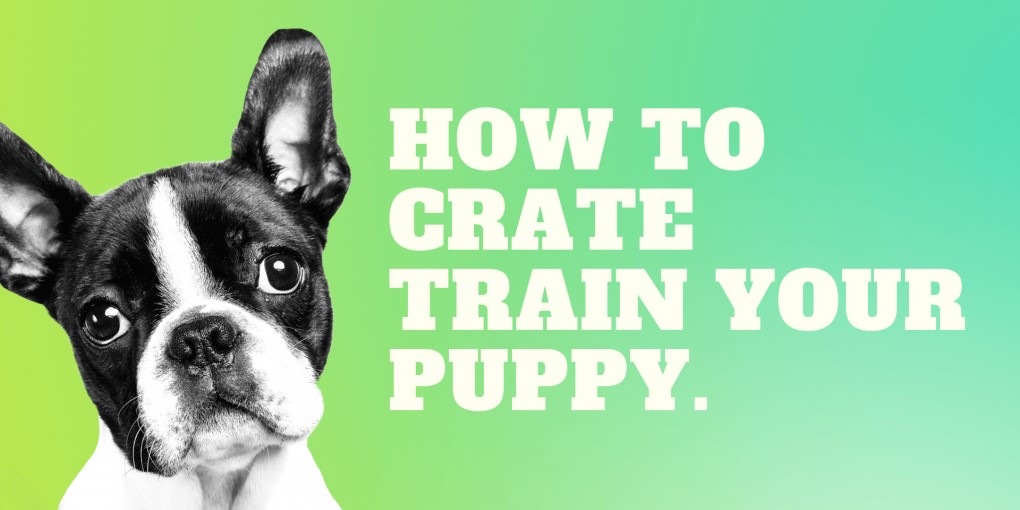
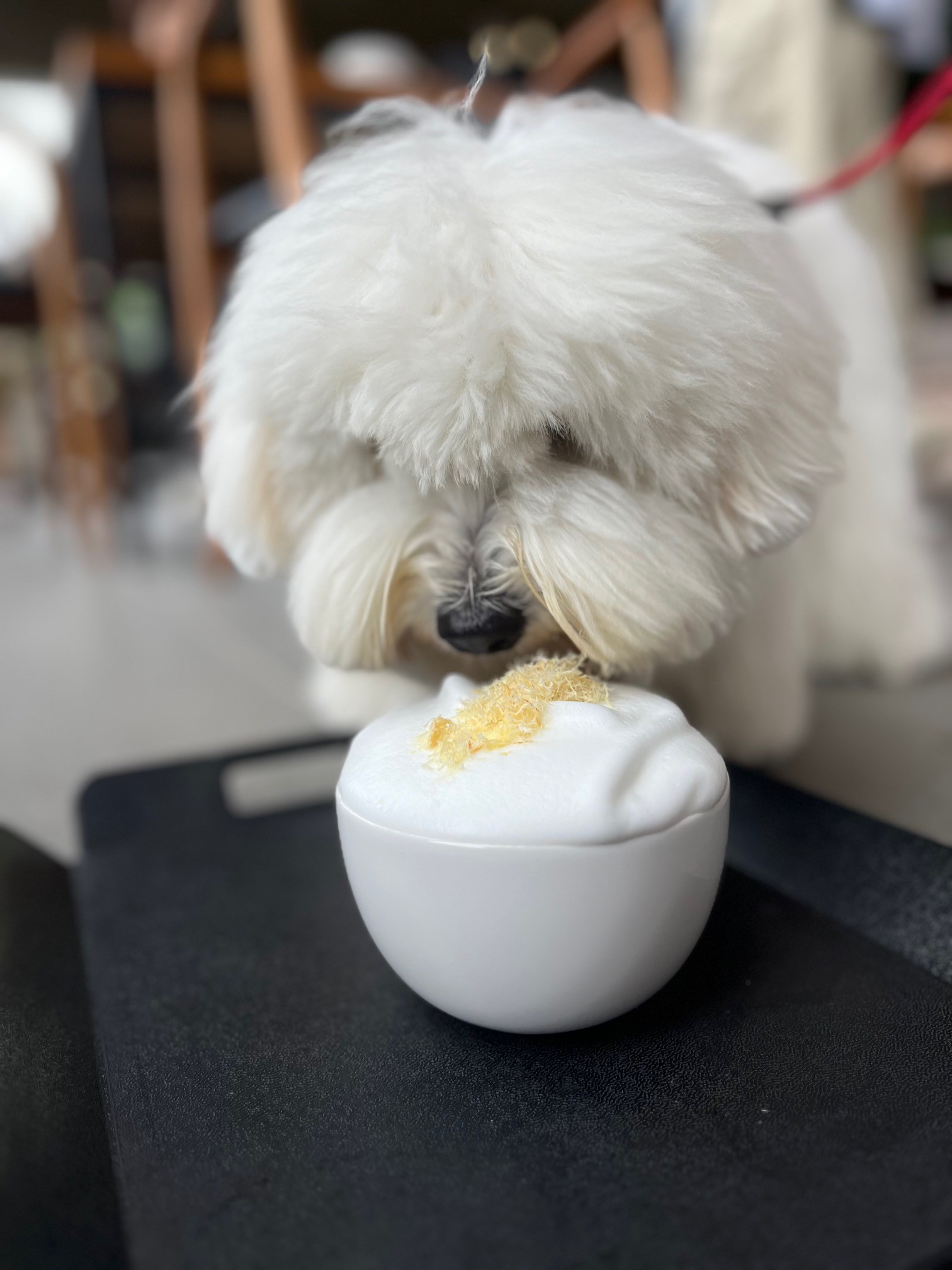
Leave a Reply